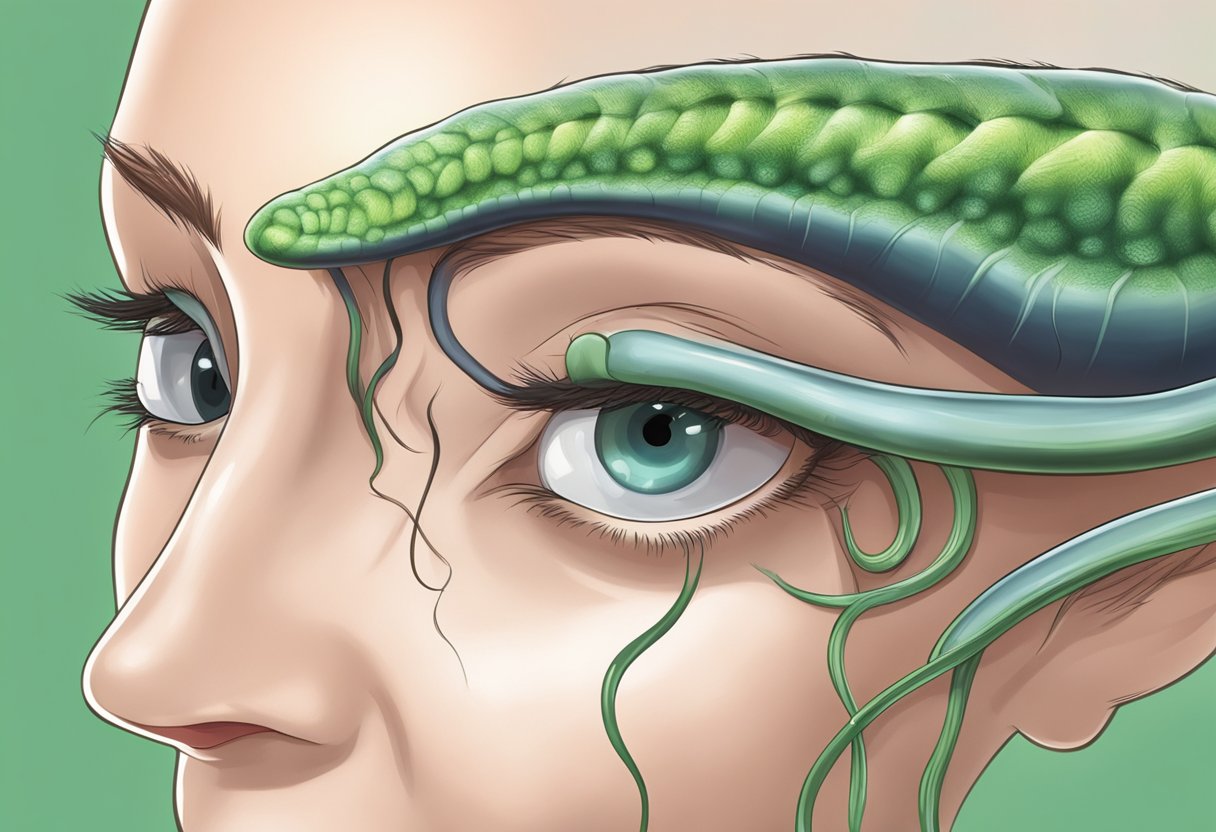Leech Therapy for Hair Loss: An Effective Treatment or Just a Myth?
Leech therapy is an ancient practice that has been used for centuries to treat various health conditions. It involves the use of medicinal leeches to suck blood from the body, which is believed to promote blood circulation and improve overall health. In recent years, leech therapy has gained popularity as a natural treatment for hair loss.

Hair loss is a common problem that affects millions of people worldwide. While there are many treatments available, including medications and hair transplant surgery, some people prefer natural remedies. Leech therapy for hair loss is one such remedy that has gained popularity in recent years. The therapy involves the use of leeches to stimulate blood flow to the scalp, which is believed to promote hair growth. While there is limited scientific evidence to support the use of leech therapy for hair loss, some people have reported positive results.
History of Leech Therapy

Leech therapy, also known as hirudotherapy, is an ancient practice that has been used for centuries to treat various ailments. The use of leeches in medicine dates back to ancient Egypt, where they were used to treat a variety of conditions, including fever, headaches, and infections. The ancient Greeks also used leech therapy to treat a wide range of ailments, including eye diseases, skin diseases, and even mental illnesses.
Ancient Practices
In ancient times, leeches were believed to have healing powers due to their ability to suck blood from the body. The ancient Greeks believed that leeches could cure a wide range of ailments, including headaches, eye diseases, and skin diseases. They also believed that leeches could help to purify the blood and remove toxins from the body.
During the Middle Ages, leech therapy was widely used in Europe to treat a variety of conditions, including fever, infections, and even the plague. However, the use of leeches declined during the Renaissance period, as new medical treatments were developed.
Modern Revival
In recent years, there has been a renewed interest in leech therapy as a treatment for various conditions, including hair loss. Leech therapy for hair loss involves the use of medicinal leeches to increase blood flow to the scalp, which can promote hair growth.
While there is some evidence to suggest that leech therapy may be effective in treating hair loss, more research is needed to determine its safety and efficacy. It is important to note that leech therapy can be dangerous if not performed by a trained professional, as there is a risk of infection and other complications.
Overall, leech therapy is an ancient practice that has been used for centuries to treat a variety of ailments. While its use declined during the Renaissance period, there has been a renewed interest in leech therapy in recent years as a treatment for hair loss and other conditions.
Mechanism of Action

Leech therapy for hair loss involves the use of medicinal leeches to stimulate hair growth. Hirudin, a component of leech saliva, is known to have anticoagulant properties that help improve blood flow to the scalp, which in turn promotes hair growth.
Leech Saliva Components
Leech saliva contains a variety of bioactive compounds such as hirudin, hyaluronidase, collagenase, and thrombin inhibitors. Hirudin is a potent anticoagulant that prevents the formation of blood clots and improves blood flow to the scalp. Hyaluronidase and collagenase are enzymes that help break down the extracellular matrix and promote tissue regeneration. Thrombin inhibitors prevent the formation of fibrin clots, which can impede blood flow and reduce nutrient supply to hair follicles. All of these components work together to stimulate hair growth.
Blood Circulation Enhancement
Leech therapy for hair loss works by enhancing blood circulation to the scalp. The suction action of the leeches helps to draw blood to the surface of the skin, which promotes vasodilation and improves blood flow to the hair follicles. This increased blood flow delivers essential nutrients and oxygen to the hair follicles, which stimulates hair growth.
In addition to promoting blood flow, leech therapy also has anti-inflammatory properties that help reduce scalp inflammation and irritation. This can be particularly beneficial for individuals with alopecia areata, a condition characterized by hair loss and inflammation of the hair follicles.
Overall, leech therapy for hair loss is a promising alternative treatment that can help promote hair growth by improving blood flow and reducing inflammation. However, more research is needed to fully understand its mechanism of action and determine its long-term safety and efficacy.
Application of Leech Therapy for Hair Loss

Leech therapy is an ancient alternative medicine practice that has been used for centuries to treat various health conditions. One of the most popular applications of leech therapy is for hair loss. Leech therapy for hair loss involves the use of medicinal leeches to stimulate blood circulation in the scalp, which in turn promotes hair growth.
Treatment Procedure
The treatment procedure for leech therapy for hair loss involves the following steps:
- The patient’s scalp is cleaned with antiseptic solution to prevent infection.
- The medicinal leeches are then placed on the patient’s scalp, specifically on the areas where hair loss is most prominent.
- The leeches are allowed to suck blood from the scalp for about 20 to 30 minutes.
- After the leeches are removed, the patient’s scalp is cleaned again to prevent infection.
It is recommended that patients undergo multiple sessions of leech therapy for hair loss to achieve the best results. The number of sessions required may vary depending on the severity of the hair loss.
Safety and Precautions
While leech therapy for hair loss is generally considered safe, there are some precautions that patients should take to minimize the risk of complications.
Firstly, it is important to ensure that the leeches used for the therapy are from a reputable source and are properly sterilized to prevent the transmission of infections. Patients should also inform their healthcare provider of any allergies they may have to leeches or any other substances used in the therapy.
Secondly, patients should avoid using any hair products or styling tools for at least 24 hours after the therapy to prevent irritation or damage to the scalp.
Finally, patients should be aware that leech therapy for hair loss is not a guaranteed solution for hair loss and may not work for everyone. It is important to consult with a healthcare provider to determine if leech therapy is the right treatment option for the patient’s specific case of hair loss.
Clinical Evidence

Research Studies
Leech therapy for hair loss is a relatively new treatment method, and there is limited scientific research available to support its effectiveness. However, some studies have shown promising results.
A randomized blinded retrospective study published in Expert Opin Biol Ther in 2020 found that the combined use of micro-needling technique, low-level laser therapy, and autologous non-activated platelet-rich plasma improved hair regrowth in patients with androgenic alopecia. The study was conducted on a small sample size, but the results were statistically significant.
Another study, published in Lasers in Medical Science in 2019, found that leech therapy combined with topical minoxidil was more effective in promoting hair growth than minoxidil alone. The study was conducted on 60 male patients with androgenic alopecia, and the results were statistically significant.
Patient Outcomes
While there is limited scientific research available, some patients have reported positive outcomes with leech therapy for hair loss. Patients have reported increased hair growth and improved hair quality after undergoing leech therapy.
It is important to note that leech therapy is not a guaranteed solution for hair loss and may not work for everyone. It is also important to receive treatment from a qualified practitioner to ensure safety and effectiveness.
Overall, while there is limited clinical evidence available, some studies and patient outcomes suggest that leech therapy may be a promising treatment option for hair loss.
Frequently Asked Questions

What are the benefits of using leech therapy for treating hair loss?
Leech therapy can be beneficial for treating hair loss as it helps to increase blood circulation to the scalp, which can deliver nutrients to the hair follicles and promote hair growth. Leeches contain a natural anticoagulant called hirudin that prevents blood from clotting. This allows the leeches to suck blood from the scalp without causing any harm.
How is leech therapy performed for hair restoration?
Leech therapy for hair restoration involves applying leeches to the scalp, where they suck blood from the scalp and release their saliva. The saliva contains enzymes and other bioactive substances that can stimulate blood circulation and promote hair growth. The therapy is usually performed in a clinic or under the supervision of a trained professional.
What is the efficacy rate of leech therapy in promoting hair growth?
There is limited scientific evidence on the efficacy of leech therapy for promoting hair growth. However, some studies have suggested that the therapy may be effective in treating certain types of hair loss, such as androgenetic alopecia. The efficacy rate of the therapy may vary depending on the individual case and the severity of the hair loss.
Are there any scientific studies supporting leech therapy for hair regeneration?
There are some scientific studies that support the use of leech therapy for hair regeneration. For example, a study published in the Journal of Cutaneous and Aesthetic Surgery found that leech therapy was effective in promoting hair growth in patients with alopecia areata. However, more research is needed to determine the long-term efficacy and safety of the therapy.
How does leech oil contribute to hair health and prevention of hair loss?
Leech oil is believed to contribute to hair health and prevent hair loss by improving blood circulation to the scalp and nourishing the hair follicles. The oil contains a variety of nutrients and bioactive substances that can promote hair growth and prevent damage to the hair. However, there is limited scientific evidence to support the use of leech oil for hair health.
What are the potential risks or side effects associated with leech therapy for hair loss?
The potential risks or side effects associated with leech therapy for hair loss may include bleeding, infection, allergic reactions, and pain. It is important to seek the advice of a trained professional before undergoing leech therapy and to ensure that the therapy is performed in a safe and hygienic environment.




